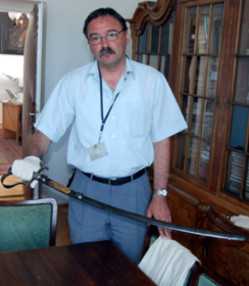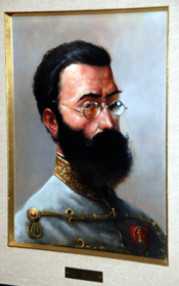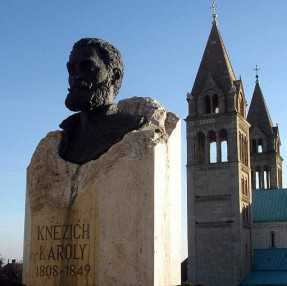Knezich Sabre: the Newest Relic
Szöveg: László Szűcs | 2008. június 9. 6:46Lieutenant General (Ret.) József Holló, the General Director of MoD Institute and Museum of Military History (HM HIM) received the ’newest’ relic of the institute, the sabre of General Károly Knezich in the framework of the celebration honouring the 160th anniversary of the establishment of the Hungarian Defence Forces. The weapon will be exhibited in the museum shortly.
"If all goes well, the sabre purchased recently will be available for the audience within a few weeks" – said Lieutenant Colonel Dr. Gyula Kedves, the Deputy Director of HM HIM Museum of Military History upon the inquiry of honvedelem.hu. The historian – an expert in the 1848-49 revolution and fight for freedom – revealed that they have had information on the whereabouts of this weapon for a long time. What is more, the Knezich relic was on display in 1999, when the temporary exhibition titled ’Retribution 1849-50’ – a tribute to the 150th anniversary of the freedom fight – was opened, since Ms Mária Dobrovics, the keeper of the weapon and great-grandchild of the general had lent the priceless sabre to the Museum of Military History.
When the descendant passed away, the weapon was acquired by a private collector who transferred it to another private individual. HM HIM has managed to purchase it from the latter person, with the support of sponsors.
"The sabre is an exceptional item in the collection of the Museum of Military History, since the 1848-49 revolution and freedom fight is a remarkable event in the history of the nation" – told us Dr. Gyula Kedves, according to whom the objects relating to the freedom fight are very sought after by private collectors as well. To this very day there are several relics of this kind which are owned by private persons, and these objects are the most prized possessions of their collections. This is exactly the same reason why it is difficult to achieve that such items are exhibited in public collections.

The historian also told us that they have planned to include the Knezich sabre in the 1848-49 permanent exhibition, which is due to open next year. He has also defined the expression ’sabre’ for us: the word is used to describe single-edged ’sword-like’ weapons with a curved blade. Straight blade weapons, for example swords, daggers, and broadswords belong to the other group of swords.
According to Dr. Gyula Kedves it is very complicated to answer the question how long did Károly Knezich use this sword, for the history of the freedom fight is full of legends and stories which are quite difficult to verify. And what makes this weapon the general’s sabre eventually? First of all the fact that his family has preserved it, and the inscription commemorating the battle of Komárom of 26 April 1849. The leading of the first phase of the battle was the greatest achievement in Károly Knezich’s military career.

“It is certain that soldiers, and mainly generals and officers serving in higher positions had more than one weapon. On the one hand they had a regular command instrument, which they had been bearing since they were promoted lieutenant, and they were granted various presents, combat trophies, for instance memorial sabres" – told us the historian according to whom this weapon has always been honoured by the family of the general as the sabre of a freedom fighter. And we can only presume that the weapon was taken to their Eger home by Katalin Kapitány, wife of the general, who stayed by his husband in the spring and summer campaigns, and this is how it got to the descendants of the generals’ two daughters.
Komárom, however, is famous not only for the 26th April battle but – as the historian told us – it had been a part of the military history of the 1848-49 freedom fight as well from several aspects. In the opinion of Dr. Gyula Kedves, should we have to sum up the events in one sentence, we could say that the majority of the decisive military operations of the fight for freedom were connected to Komárom. The first battle on the 26th of April was followed by three larger, and numerous smaller fights. Moreover, after the victorious battle in April, Hungarian soldiers set off for the final military maneuver of the spring campaign, the reoccupation of the Buda Castle, from the town of Komárom.

Naturally, the castle of Komárom played a key role in the summer campaign as well. Görgey’s concept was to fight the decisive battles of the freedom fight relying on the fortress. The government, however, brought a different decision and ordered concentration in the area where the rivers Tisza and Maros meet. Therefore the main host left Komárom and from that time on, General György Klapka – leading two armies – defended the castle. Even though the main host of the imperial troops followed the Hungarian army, the enemy closed in around Komárom. The Hungarians launched several successful attacks against the besiegers. For instance on 3rd August they crushed the siege with a powerful breakthrough, cut connections between Vienna and the main host of the Austrians, liberated northwestern Transdanubia, and enlisted 5,000 new recruits.
They had prepared to perform diversionary acts in the background, and expected the Hungarian main army to return to Komárom and continue the fight for freedom with joint forces. This was exactly why they were shocked to hear about the major losses of the Hungarian forces in the south, and the capitulation at Világos. Knezich’s men retreated to the castle and defended it with success until October. The siege ended with negotiations that led to the conclusion of an agreement, and the troops of the Komárom army laid down their arms between 2-5 October after they had been granted amnesty.

On the following day the high ranking soldiers of the Hungarian freedom fight were executed in Arad. General Károly Knezich, sentenced to be hanged, was one of them…